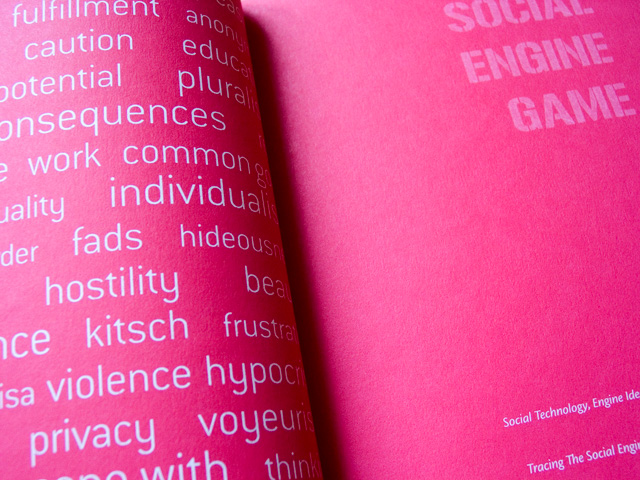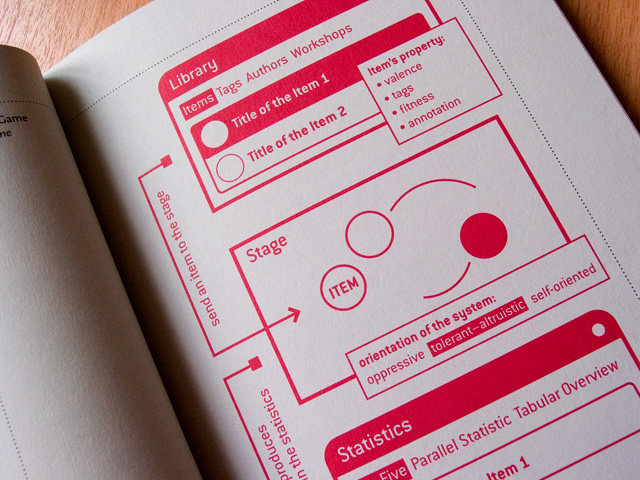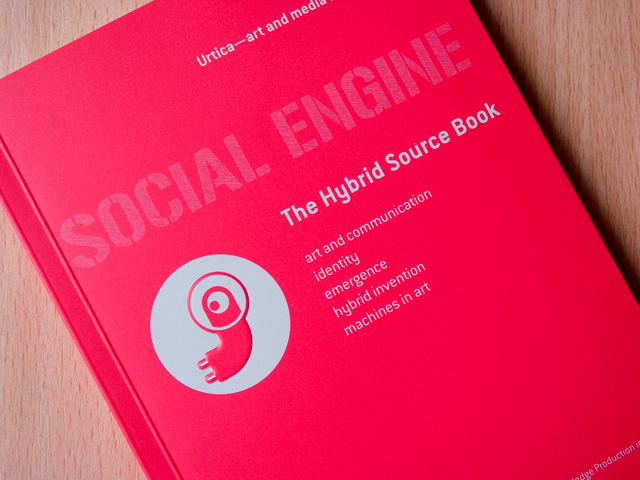
|
Social Engine—The Hybrid Source BookVioleta Vojvodić and Eduard Balaž (Ed.)
|
- Book view
- + more
 Excerpt from conversation between Andrei Siclodi and Urtica
Excerpt from conversation between Andrei Siclodi and Urtica-
Art and Science
Knowledge production releated to art and science
-
Keywords / Tags
- Database art,
- Symbolic communication,
- Knowledge generator,
- Identity,
- Emergence,
- Hybrid invention,
- Machines in art,
- Transdisciplinarity,
Art-Bio:
Book Premiere
- 2008
- “Social Engine – The Hybrid Source Book,” presentation at Künstlerhaus Büchsenhausen, Innsbruck, Austria
The book is dedicated to artistic project Social Engine. It comprises essays that overlap the fields of interest of the contributing authors Andrei Siclodi, Zoran Erić, Bill Seaman, Igor Balaž, Staniša Dautović, and the issues that Urtica’s Social Engine dealt with. The art project Social Engine started up within the framework of the artist-in-residence program at Künstlerhaus Büchsenhausen in Innsbruck.
Social Engine—The Hybrid Source Book
Preface excerptThis book marks the beginning of a new series of publications released by Künstlerhaus Büchsenhausen. Büchs’n’books—Art and Knowledge Production in Context brings together publications by artists and theoreticians who conceive of their work as a specific contemporary production of knowledge, as well as anthologies that deal contextually with this complex field. The authors in this series are, for the most part, alumni of the fellowship program for visual art and theory at Büchsenhausen, a program for supporting artists and theorists active in this field.
Among the many practices of knowledge production associated with art, those practices that take up an avant-garde role interweave aesthetic concepts with technical, socio-political, and other notions from the field of communication science. The development of modern art from the beginning of the 20th century describes an unfinished process of turning away from a metaphysical worldview to a constructivistically generated one. In a society whose functional systems are driven by technological and economic organizational competence, the art system cannot exist outside of any empirical “processuality” of everyday life. An art that is socially relevant reflects, comments on, and transforms tendencies, conflicts, crises, and phenomena from various areas of life by aesthetic means, and, in this way, it generates a “surplus value of knowledge.”
Urtica’s Social Engine, in my opinion, meets this precondition. The project combines knowledge contingents from the fields of art and design, as well as from information, evolution, and cognition theory to form a model of representation of reality whose potential for conflict goes well beyond the cultural sphere. Insights won through the process of artistic interdisciplinary research and knowledge processing here almost inevitably lead to the formulation of simulative models of action that, hardly surprisingly, turn out to be instructive indicators of an experience of reality. And when we assume that the field of art is constituted as a sphere for rehearsing the social forms of action of various subjects, politics, and economies, we indeed may regard the Social Engine as a “battlefield of ideas,” which establishes itself as a particular zone of the public sphere. This conclusion largely corresponds to the verdicts of communication and evolution theory. A fact that, no doubt, amounts to a surplus value of knowledge.
Andrei Siclodi
Editor of the series büchs'n'books—Art and Knowledge Production in Context
Social Engine Table of Contents:
I Social Engine Game
-
4 | Foreword by Andrei Siclodi
… Being a game, the Social Engine may be considered to be itself a kind of simulation… Thus, the question arises as to how a game, a symbolic representation of a particular segment of the “world,” can influence the behavior of its users beyond the symbolic sphere… -
8 | Social Technology, Engine Ideology, Game Outcomes by Violeta Vojvodić
… The Social Engine can be defined as a transproduct, i.e., a product of transdisciplinary research and practice, whose outlets are an Internet application, workshops, and Art-Acts… - 25 | Tracing The Social Engine—Photo Documentation
-
42 | But First You Have to Trust, a conversation piece made by Andrei Siclodi, and Violeta Vojvodić and Eduard Balaž from Urtica
… Yes, as you said, discourse can have an instrumental function for governance and control within human society through the distribution of certain norms, values, and biases. Adoption and reinforcement of particular socio-cultural patterns have an impact on people’s individual and social behavior. In that sense, the notion of a meaning which is turned into an action is the driving force behind the cognitive and the computing structure of the device which we defined as the Social Engine…
tags: art, design, symbol, database, performativity, education, knowledge production, transdisciplinarity
II Knowledge Generator
-
68 | Passages on Identity by Zoran Erić
… With the advent of the information era, our self is increasingly connected to the world through the screen... How could we possibly think of the personal, self-identity beyond the social conditions that interfere and influence its formation?…
tags: Identity, production of social space, democracy, sovereignity -
78 | Emergence of Non-Designed Functionality: Prerequisites/Consequences by Igor Balaž
… Assimilation, which derives from semiosis, is a functional category and as such begins with a sign and ends with readiness for transformation of the environment…
tags: Emergence, functionality, self-organization -
88 | The Hybrid Invention Generator by Bill Seaman
… The mind-set of the participant represents an active field in that the work is highly associative in nature. The participant becomes dynamically involved in the construction of inventions as well as in the construction of emergent meaning…
tags: hybrid, invention, fields of meaning, generative art, meta-meaning, nonsense relations, brainstorming tool -
104 | Formal Systems and Universal Machines in Arts by Staniša Dautović
… An artist as a source of information who emits non-redundant artistic ideas. In that way, the artist-Cathodic joins the general explosion of information, fighting on his own way against the implosion of the meaning…
tags: formal systems, minimal algorithm, universal machine, computer art
124 | Biographies
2008
Urtica – art and media research group
Social Engine – The Hybrid Source Book
Violeta Vojvodić and Eduard Balaž (Ed.)
With texts by Zoran Erić, Igor Balaž, Bill Seaman, Staniša Dautović, Andrei Siclodi and Violeta Vojvodić (Urtica)
büchs’n’books—Art and Knowledge Production in Context, Volume 1, edited by Andrei Siclodi
Published by Künstlerhaus Büchsenhausen, Innsbruck, Austria
Printed in Serbia, 2008
ISBN: 978-3-9502583-0-1

 People of Europe, Guard Your Precious Values
People of Europe, Guard Your Precious Values The Art in Liquidation
The Art in Liquidation Art and Crisis - Facing Bureaucrat (video)
Art and Crisis - Facing Bureaucrat (video) VQ Bourse - The Value is Here
VQ Bourse - The Value is Here VQ - Art of Fortune and Economy of Risk
VQ - Art of Fortune and Economy of Risk VQ - Golden Card
VQ - Golden Card That Which Changes
That Which Changes Who is Guarding the Guardians?
Who is Guarding the Guardians? Social Engine
Social Engine Dictionary of Primal Behaviour
Dictionary of Primal Behaviour Lapsus Memoriae
Lapsus Memoriae Kumova Sekira
Kumova Sekira Omnigenus
Omnigenus Urtica Medicamentum Est
Urtica Medicamentum Est Social Engine - The Hybrid Source Book
Social Engine - The Hybrid Source Book

